
Environmental Biotechnology - Jordening and Winter
.pdf
232 8 Principles of Anaerobic Degradation of Organic Compounds
cently with samples from deep-sea sources, and efficient methane oxidation requires enhanced methane pressure (Nauhaus et al., 2002).
Unsaturated long-chain hydrocarbons with terminal double bonds can be hydrated to the corresponding primary alcohols (although against the Markownikoff rule) and completely degraded (Schink, 1985a). A branched-chain unsaturated hydrocarbon such as squalene was degraded in methanogenic enrichment cultures (Schink, 1985a); however, degradation was incomplete, probably due to the formation of saturated branched derivatives. Other unsaturated isoprene derivatives such as terpenes have been shown recently to be completely degraded, with nitrate as electron acceptor (Harder and Probian, 1995; Foß and Harder, 1998; Foß et al., 1998). Although the structures of terpenes differ substantially with respect to the way of possible attack, an amazingly broad variety of terpenes was completely degraded. Some concepts of the biochemistry of degradation of these compounds have been developed (Hylemon and Harder, 1999),but experimental evidence is still lacking. Acetylene, a highly unsaturated hydrocarbon, is fermented comparably rapidly to acetate and ethanol through acetaldehyde (Schink, 1985b), which is formed by a hydratase enzyme (Rosner and Schink, 1995). Acetylene hydratase is an iron-sulfur protein containing a tungsten cofactor (Meckenstock et al., 1999); it is active only in the reduced state, but the reaction mechanism is still unknown. No anaerobic degradation has been documented so far for ethylene, propylene, propine, and higher homologs having up to six carbon atoms.
8.2.2
Degradation of Ether Compounds and Nonionic Surfactants
Ether linkages are rather stable, and their chemical cleavage requires severe conditions, e.g., boiling at strongly alkaline or acidic pH. Biological ether cleavage in the presence of oxygen employs oxygen as cosubstrate in an oxygenase reaction, which transforms the ether into an unstable hemiacetal (Bernhardt et al., 1970). Thus, methyl groups of lignin monomers are released as formaldehyde, not as methanol.
Anaerobic demethylation of lignin monomers by the homoacetogen Acetobacteri- um woodii was first described by Bache and Pfennig (1981) and later was repeatedly observed with several other homoacetogens. The mechanism of this phenyl methyl ether cleavage were only recently elucidated. Studies with the homoacetogen Ho- lophaga foetida showed that the methyl group is first transferred as a methyl cation to a fully reduced cob(I)alamin carrier, which later methylates the coenzyme tetrahydrofolate (Fig. 8.1; Kreft and Schink, 1993, 1994). Similar studies with Acetobacteri- um woodii, Sporomusa ovata, or Acetobacterium dehalogenans revealed that also in these species, the methyl group is transferred as a methyl cation, but that the details of further methyl transfer to coenzymes may differ with the strain studied (Berman and Frazer, 1992; Stupperich and Konle, 1993; Kaufmann et al., 1997; Kaufmann et al., 1998; Engelmann et al., 2001).
A different type of anaerobic ether cleavage was observed with the synthetic polyether polyethylene glycol (PEG). Formation of acetaldehyde as the first cleavage product, extreme oxygen sensitivity of the ether-cleaving enzyme in cell-free ex-
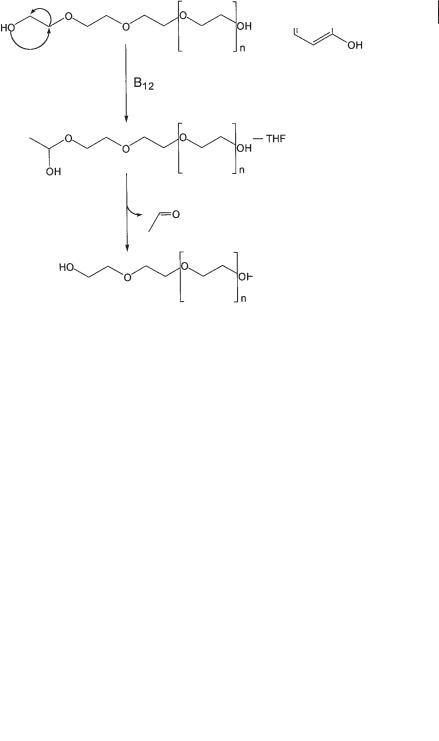
8.2 Key Reactions in Anaerobic Degradation of Certain Organic Compounds 233
Fig. 8.1 Anaerobic demethylation of phenyl methyl ethers. Co(I), Co(III), cobalamin in different redox states; THF, tetrahydrofolate.
tracts, and interference with cobalamins strongly suggest that the first step in this degradation is a cobalamin-dependent shift of the terminal hydroxyl group to the subterminal C atom, analogous to a diol dehydratase reaction (Fig. 8.2; Schramm and Schink, 1991; Frings et al., 1992). This reaction again transforms the ether into a hemiacetal derivative that decomposes spontaneously. Since the ether-cleaving enzyme is located in the cytoplasmic space, the polymeric PEG (which has molecular mass up to 40 kDa) has to cross the cell membrane(s) before it is cleaved inside, and the same is true for PEG-containing nonionic surfactants. Since the bacterial strains studied so far are specialized only for the degradation of the PEG chain, the lipophilic residues of the surfactants have to cross the membrane(s) again on their way back
Fig. 8.2 Anaerobic degradation of polyethylene glycol by fermenting bacteria. B12, coenzyme B12.

234 8 Principles of Anaerobic Degradation of Organic Compounds
out. It is obvious that these transport steps considerably limit the applicability of such degradation capacities to treatment of, e.g., wastewaters rich in such surfactants. Nonetheless, the applicability of anaerobic fixed-bed reactors for treatment of nonionic surfactants of various types to methane, CO2, and mixtures of fatty acids has been demonstrated (Wagner and Schink, 1987, 1988).
The anaerobic ether cleavage reactions described here proceed only inside the bacterial cell. In this, they differ from the corresponding reactions reported for certain basidiomycetes (Kerem et al., 1998), which use these cleavage capacities, e.g., in lignin degradation. It is not surprising, therefore, that highly polymeric, condensedether compounds such as lignin are not degraded to any significant extent in the absence of molecular oxygen.
8.2.3
Degradation of N-Alkyl Compounds and Nitrilotriacetate
Among the natural N-alkyl compounds are, in addition to t he amino acids, several methylated amines such as trimethylamine, which is formed during the initial decay of fish tissue through reduction of trimethylamine-N-oxide by several enterobacteria and others. Under strictly anoxic conditions, methanogenic archaea have been found to efficiently demethylate trimethylamine via dimethylamine to monomethylamine and to ferment the methyl moieties by dismutation to methane and CO2 (Hippe et al., 1979). The cleavage between the nitrogen and the neighboring carbon atom is accomplished by a nucleophilic attack by a cob(I)alamin, analogous to the demethylation of phenyl methyl ethers by homoacetogenic bacteria (see above). So far, only methanogens have been found to demethylate methylamines, whereas homoacetogens appear to be specialists for demethylation of phenyl methyl ethers which, in turn, are not attacked by methanogens. It should be emphasized at this point that the strategy of methyl cation removal by cob(I)alamin derivatives is applicable only to these one-carbon compounds. Ethyl or higher homologs cannot be cleaved this way.
N-alkyl compounds of technical and environmental concern include ethylenediaminetetraacetate (EDTA) and nitrilotriacetate (NTA); the latter has largely replaced polyphosphates as a calcium chelator in most commercial washing detergents. The main problem in degrading EDTA is the formation of strong complexes of EDTA with metal ions, which make this substrate very difficult to attack. Nonetheless, microbial EDTA degradation in the presence of oxygen has been documented (- Nörtemann, 1992), but no reports exist on possible anaerobic degradation of EDTA. NTA is degraded aerobically through oxygenase-dependent hydroxylation of one methylene carbon. The resulting hydroxy compound is unstable and releases glyoxylic acid. Removal of an additional carboxymethylene residue produces glycine as coproduct. Anaerobic degradation of NTA is possible with nitrate as electron acceptor. The first degradation step is dehydrogenation to an unsaturated iminium derivative which, upon hydration, can again release glyoxylic acid to form the iminodiacetate derivative (Egli et al., 1990). Since oxidation of NTA to the unsaturated derivative has a rather high redox potential (> +100 mV), it is not surprising that so far, only nitrate

8.2 Key Reactions in Anaerobic Degradation of Certain Organic Compounds 235
reducers have been found to be able to degrade NTA. We have to assume that, under strictly reducing conditions, i.e., in deeper sediment layers, NTA is stable to microbial attack, because neither sulfate-reducing nor fermenting bacteria can release electrons arising at this high redox potential.
8.2.4
Degradation of S-Alkyl Compounds
Dimethylsulfoniopropionate is an osmoprotectant found in several green algae and seaweeds. Its cleavage by anaerobic bacteria leads to acrylate and dimethylsulfide, which can escape into the atmosphere. The thioether dimethylsulfide can also be degraded anaerobically by methanogenic archaea (Kiene et al., 1986; Oremland et al., 1989). The carbon-sulfur linkage is cleaved by methyl cation removal, analogous to the demethylation reactions described above (Keltjens and Vogels, 1993).
8.2.5
Degradation of Ketones
Aerobic degradation of ketones appeared to be well established. Indications of an oxygenase-catalyzed hydroxylation of acetone to acetol by aerobic bacteria were provided early (Lukins and Foster, 1963; Taylor et al., 1980), but this type of reaction was never confirmed unequivocally. Anaerobic degradation of acetone by nitrate-reduc- ing, sulfate-reducing, or fermenting bacteria cooperating with methanogenic partners uses a carboxylation reaction as primary step of activation, leading to an acetoacetyl derivative that undergoes subsequent cleavage to two acetate moieties (Fig. 8.3; Platen and Schink, 1987, 1989; Bonnet-Smits et al., 1988; Platen et al., 1990). Unfortunately, the primary carboxylation reaction was never convincingly proved with these cultures. Very little acetone carboxylation activity was observed in enzyme assays (Platen and Schink, 1991) or in radiotracer experiments using suspensions of intact cells (Janssen and Schink, 1995). Acetone carboxylation activity in the phototrophic anaerobe Rhodobacter capsulatus was also very weak in vitro (Birks and Kelly, 1997). An acetone-carboxylating enzyme complex of high activity has been found in an aerobic Xanthobacter strain (Sluis et al., 1996) and was purified and characterized (Sluis and Ensign, 1997; Sluis et al., 2002). The reaction requires as energy source for the acetone carboxylation reaction one ATP, which is hydrolyzed to AMP plus
Fig. 8.3 Anaerobic degradation of acetone through carboxylation.

236 8 Principles of Anaerobic Degradation of Organic Compounds
two Pi. Whether sulfate-reducing or fermenting bacteria provide the necessary energy for carboxylation in different ways still has to be examined. The fermenting bacteria especially cannot afford to spend the equivalent of two ATP molecules on this carboxylation reaction. To our surprise, all aerobic bacteria enriched with acetone also used a carboxylation step rather than an oxygenase reaction in acetone activation, even if CO2 was trapped during the enrichment process (Schink, unpublished data). Thus, the original reports of oxygenase-dependent acetone activation may describe an exceptional situation with one single strain, which is not representative of the majority of aerobic acetone degraders.
Higher homologs of acetone appear to be attacked in a similar manner by carboxylations. This applies also to acetophenone, the phenyl-substituted analog of acetone (Schink, unpublished data).
8.2.6
Degradation of Aromatic Compounds
In aerobic degradation of aromatic compounds, oxygenases activate the comparably stable oxygen molecule in such a way as to produce highly electrophilic species, which add to a comparably inert aromatic compound to form hydroxylated products such as catechol (Dagley, 1971; Schlegel, 1992). A further oxygenase-dependent step opens the aromatic ring, either between or vicinal to the two hydroxyl groups of catechol, thus forming an unsaturated, open-chain carboxylic acid which undergoes further degradation, typically to an acetyl and a succinyl derivative.
That aromatic compounds can also be degraded anaerobically was documented as early as 1934: a broad variety of mononuclear aromatic compounds, such as benzoate, phenols, and several lignin monomers, was converted stoichiometrically to methane and CO2 (Tarvin and Buswell, 1934). Later these observations were forgotten, and some textbooks maintained even into the 1980s the dogma that aromatics can be attacked only with oxygen as cosubstrate. During the 1970s, Evans (1977) developed the concept that destabilization of the aromatic nucleus in the absence of oxygen could proceed through a reductive rather than an oxidative reaction. Today we know at least three different pathways of anaerobic degradation of mononuclear compounds, i.e., the benzoyl-CoA pathway, the resorcinol pathway, and the phloroglucinol pathway (Evans and Fuchs, 1988; Schink et al., 1992; Fuchs et al., 1994; Heider and Fuchs, 1997; Schink et al., 2000). ln all these pathways, a 1,3-dioxo structure is formed through a reduction step, either inside the ring itself or in combination with a carboxyl coenzyme A moiety. This structure allows a nucleophilic attack on one of the ring ketone carbon atoms and subsequent ring fission. Depending on the aromatic substrate, either a pimelic (C7-dicarboxylic) residue bound to coenzyme A or a partly oxidized caproic (C6-monocarboxylic) acid is formed, which undergoes subsequent beta oxidation to three acetyl moieties. Formation of other products in fermentative benzoate degradation, such as succinate or propionate as claimed in earlier papers, could never be reproduced with defined cultures and may have been due to uncontrolled side reactions or misinterpretations of insufficient chemical analyses.
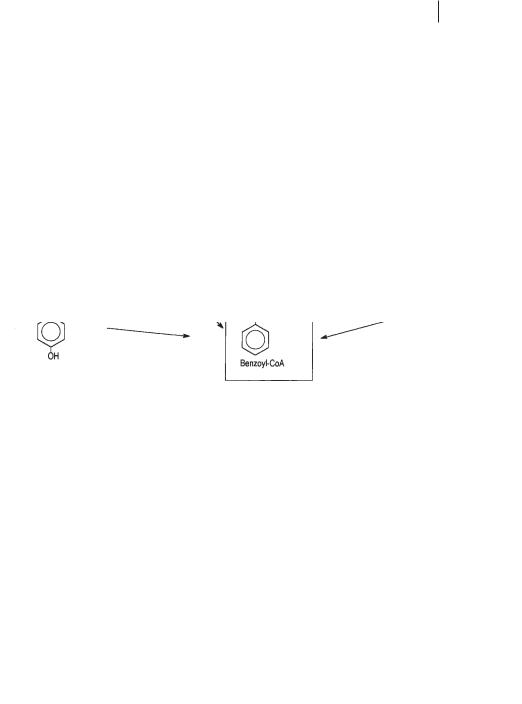
8.2 Key Reactions in Anaerobic Degradation of Certain Organic Compounds 237
8.2.6.1Benzoate and the Benzoyl-CoA Pathway
The benzoyl-CoA pathway appears to be the most important one in anaerobic degradation of aromatics, because a broad variety of compounds enter this path, including phenol, various hydroxybenzoates, phenylacetate, aniline, certain cresols, and even the hydrocarbon toluene (Fig. 8.4; Schink et al., 1992; Heider and Fuchs, 1997; Harwood et al., 1999). Once benzoyl-CoA is formed, the stability of the aromatic ring structure is overcome by a reductive step that introduces two single electrons and protons, through radical intermediates, to form cyclohexadiene carboxyl-CoA as the first identifiable product (Fig. 8.5; Koch et al., 1993; Boll and Fuchs, 1995; Boll et al. 2000a). Because reduction of the benzene ring to a cyclohexadiene derivative, even with electrons at the ferredoxin level (Boll et al., 2000b) is endergonic, it requires the investment of energy in the form of two ATP molecules (Boll and Fuchs, 1995; Harwood et al., 1999). Nitrate-reducing bacteria can recover this energy investment through the further breakdown of the C7-dicarboxylic acid derivative produced upon ring cleavage, via beta oxidation to three acetyl-CoA residues that are finally oxidized in the citric acid cycle. Fermenting bacteria and sulfate-reducing bacteria recover on-
Fig. 8.4 Overview of mononuclear compounds entering the benzoyl-CoA pathway of anaerobic degradation (courtesy of Prof. G. Fuchs, Freiburg).
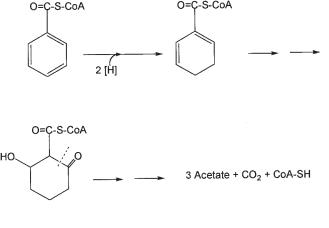
238 8 Principles of Anaerobic Degradation of Organic Compounds
Fig. 8.5 Initial steps in anaerobic degradation of benzoate by the nitrate-reducing bacterium
Thauera aromatica.
ly a little energy in the further breakdown of the open-chain intermediate. They may use a different type of reaction for benzoyl-CoA dearomatization that leads to a cyclohexene carboxyl derivative (Schöcke and Schink, 1999; Harwood et al., 1999) or to a hydroxylated derivative through hydroxylations catalyzed by seleniumor molybde- num-containing enzymes (Peters et al. 2004). However, the biochemistry of these new reactions still needs to be elucidated.
8.2.6.2 Phenol, Hydroxybenzoates, and Aniline
Aromatic compounds that do not carry a carboxyl group, such as phenol or aniline, are first carboxylated to a p-hydroxy or a p-amino benzoic acid residue, which is subsequently activated with coenzyme A (Fig. 8.6; Tschech and Fuchs, 1989; Lack and Fuchs, 1992; Schnell and Schink, 1991). The carboxylation of phenol by a nitrate-re- ducing Thauera aromatica strain can be followed in vitro with phenyl phosphate as substrate, which is carboxylated to 4-hydroxybenzoate and further degraded as such (see below). The phosphate donor for phenol phosphorylation is still unknown (Lack and Fuchs, 1992, 1994; Breinig et al., 2000). Whether sulfate-reducing bacteria or fermenting bacteria cooperating with methanogenic partners use the same pathway for phenol degradation also remains to be examined. An H/D exchange at carbon atom 4 of phenol by cell suspensions of a methanogenic phenol-degrading enrichment culture indicates that these cultures also activate phenol through carboxylation at this position (Gallert et al., 1991). Whether the carboxylation reaction in these fermentative bacteria is also initiated by phenol phosphorylation is still an open question. The overall energy budget of fermentative phenol degradation is very tight and hardly allows spending a full ATP equivalent or even more on this carboxylation reaction. The biochemistry of phenol degradation by sulfate-reducing bacteria has not been studied so far, but it is likely to proceed basically through the same pathway.
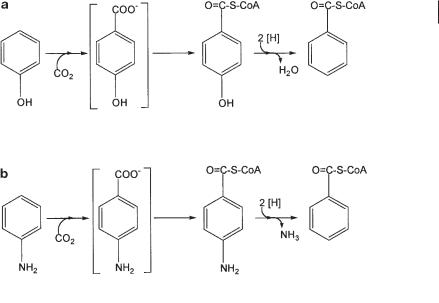
8.2 Key Reactions in Anaerobic Degradation of Certain Organic Compounds 239
Fig. 8.6 Anaerobic degradation of (a) phenol and (b) aniline by anaerobic bacteria. The compounds in brackets have not been identified.
The 4-hydroxybenzoate formed is activated through a ligase reaction, analogous to benzoyl-CoA formation from benzoate, to form 4-hydroxybenzoyl-CoA, which is subsequently reductively dehydroxylated to benzoyl-CoA (Fig. 8.6a).
4-Hydroxybenzoate may be degraded anaerobically through the same pathway. However, in cultures 4-hydroxybenzoate is not stable but is slowly decarboxylated to phenol, perhaps by an enzyme activity related to phenyl phosphate carboxylase.
3-Hydroxybenzoate is comparably stable and does not decarboxylate spontaneously. Instead, the hydroxyl group is reductively eliminated by fermenting bacteria to allow further degradation through the benzoyl-CoA pathway, as shown with Sporoto- maculum hydroxybenzoicum (Müller and Schink, 2000).
Aniline is degraded anaerobically through a pathway analogous to that for phenol degradation. The initial activation is accomplished through carboxylation to 4-ami- nobenzoate, which is subsequently activated to 4-aminobenzoyl-CoA and undergoes reductive deamination to benzoyl-CoA (Fig. 8.6b; Schnell and Schink, 1991). The initial carboxylation reaction has not been studied in cell-free extracts so far, and nothing is known about an activated intermediate that can provide the carboxylation reaction with the necessary energy.
Aminobenzoates, diaminobenzenes, and aminohydroxybenzenes are degraded very slowly in anaerobic enrichment cultures, and nothing is known about the degradation pathways (Schnell and Schink, unpublished data).
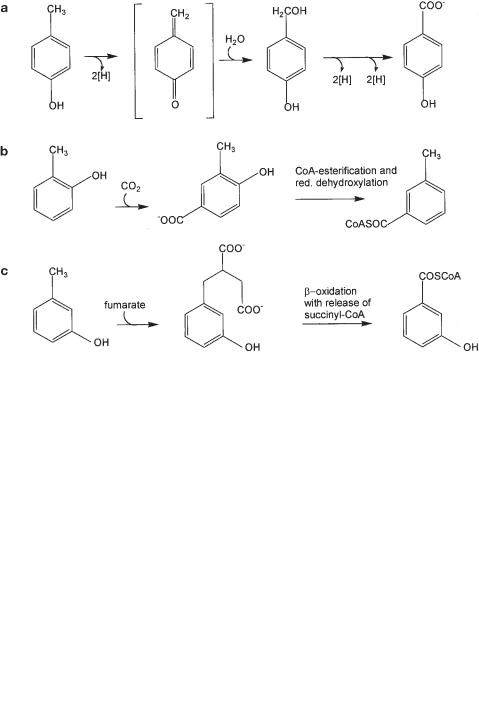
240 8 Principles of Anaerobic Degradation of Organic Compounds
8.2.6.3 Cresols
Cresols (methylphenols) are anaerobically degraded through three different pathways, depending on the type of substitution. p-Cresol is hydroxylated at the methyl group by an oxygen-independent reaction, probably through a quinomethide intermediate as suggested earlier for an aerobic Pseudomonas strain (Fig. 8.7a; Hopper, 1978). The redox potential of this oxidation reaction is in the range of +100 mV (calculated after Thauer et al., 1977), and the reaction is therefore easy to do for a nitratereducing bacterium that couples this oxidation, e.g., with the reduction of a c−type cytochrome at +235 mV (Hopper et al., 1991). Sulfate-reducing or fermenting bacteria, on the other hand, have difficulty in disposing of these electrons. o-Cresol can be carboxylated to 3-methyl-4-hydroxybenzoate and further degraded as such (Fig. 8.7b; Bisaillon et al., 1991; Rudolphi et al., 1991). An alternative pathway could lead through methyl group hydroxylation, analogous to p-cresol, to form salicylic acid as an intermediate (Suflita et al., 1989; Schink et al., 1992), but this pathway has only been hypothesized so far. The pathway of anaerobic m-cresol degradation has been elucidated recently in the sulfate-reducing bacterium Desulfobacterium cetonicum. This degradation follows a strategy analogous to anaerobic toluene degradation by nitrate-reducing bacteria (Müller et al., 1999): the methyl group of m-cresol adds to fumarate to form 3-hydroxybenzylsuccinate. Activation and beta oxidation lead to
Fig. 8.7 Anaerobic degradation of cresols. (a) Degradation of p-cresol, (b) degradation of o−cresol, (c) degradation of m-cresol.

8.2 Key Reactions in Anaerobic Degradation of Certain Organic Compounds 241
succinyl-CoA and benzoyl-CoA (Fig. 8.7c). Thus, the new type of methyl group activation by addition to fumarate appears not to be restricted to the activation of hydrocarbons (see below).
8.2.6.4Hydroquinone and Catechol
Hydroquinone is degraded by sulfate-reducing and fermenting bacteria. The degradation pathway has been studied in a sulfate-reducing Desulfococcus strain (Gorny and Schink, 1994a) and a fermenting bacterium that was later described as Syntro- phus gentianae (Gorny and Schink, 1994b). In both species, hydroquinone is carboxylated to gentisic acid; again, this carboxylation could not be studied in cell-free extracts and the way of energization of this reaction is unknown. Gentisate is activated to gentisyl-CoA through a CoA-ligase reaction and reductively dehydroxylated to benzoyl-CoA, which enters the modified benzoyl-CoA pathway. The dehydroxylation of both hydroxyl groups appears to proceed in a single step. Alternatively, gentisic acid is utilized by the fermenting bacterium.
Catechol, the key intermediate in aerobic breakdown of aromatic compounds, is by far the slowest phenolic compound to be degraded under anoxic conditions. The biochemistry of catechol degradation has been studied so far only in a sulfate-reduc- ing Desulfobacterium strain, which carboxylates catechol to protocatechuate (Gorny and Schink, 1994c). Protocatechuate is activated to form protocatechuyl-CoA, which is subsequently dehydroxylated to benzoyl-CoA. Efforts to isolate nitrate-reducing or fermenting bacteria with hydroquinone or catechol as substrate have failed so far.
8.2.6.5Resorcinol
An entirely different strategy is used in the anaerobic degradation of resorcinol and its derivatives. The two hydroxyl groups in resorcinol are in positions relative to each other that allow tautomerization to a cyclohexene dione derivative having three isolated double bonds (Fig. 8.8a). Cell-free extracts of a fermenting Clostridium strain convert resorcinol to dihydroresorcinol (cyclohexanedione; Tschech and Schink, 1985; Kluge et al., 1990), which is further hydrolyzed to 5-oxohexanoate, probably through a nucleophilic attack on one of the carbonyl carbon atoms (Fig. 8.8a).
The resorcinol carboxylates â- and ã-resorcylate are degraded by the same fermenting bacterium after decarboxylation to resorcinol. These decarboxylations are chemically easy, because in these compounds the carboxylic group is located ortho or para to electron-withdrawing hydroxyl groups.
In cultures of nitrate-reducing bacteria growing with resorcinol as the sole substrate, no resorcinol-reducing activity could be identified (Kluge et al., 1990; Gorny et al., 1992). The nitrate reducer Azoarcus anaerobius destabilizes the ring by introducing an additional hydroxyl group to form hydroxyhydroquinone (Fig. 8.8b; Philipp and Schink, 1998). The enzyme involved is membrane-bound, and the hydroxylation is coupled to reduction of nitrate to nitrite. In a later oxidation step, hydroxyhydroquinone is oxidized to hydroxybenzoquinone (Philipp and Schink, 1998). The ring fission reaction has not been resolved yet.
